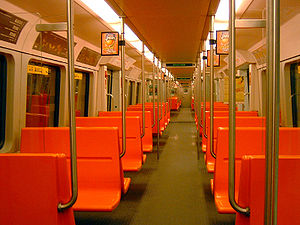
VR-Group Plc, commonly known as VR, is a government-owned railway company in Finland. VR's most important function is the operation of Finland's passenger rail services with 250 long-distance and 800 commuter rail services every day. With 7,500 employees and net sales of €1,251 million in 2017, VR is one of the most significant operators in the Finnish public transport market area.

Helsinki City Transport or HKL is the official city-owned public transport company in Helsinki, Finland. It operates the Helsinki Metro. HKL's bus operations were merged with another city-owned company, Suomen Turistiauto, to form a new bus company called Helsingin Bussiliikenne, which has since been acquired by Koiviston Auto. Until the founding of HSL in January 2010, HKL was responsible for the planning and organization of all public transport in Helsinki.
The mission of Helsinki City Transport is to enable equal mobility for all and to create the preconditions for a well-functioning and vital city.

The Helsinki Metro is a rapid transit system serving Greater Helsinki, Finland. It is the world's northernmost metro system. It was opened to the general public on 2 August 1982 after 27 years of planning. It is operated by Helsinki City Transport for HSL and carries 92.6 million passengers per year.

Helsinki commuter rail is a commuter rail system serving Greater Helsinki and the surrounding county of Uusimaa. The system is a joint venture between the regional transport authority HSL and national railway operator VR.

Vuosaari metro station is the ground-level terminus station of the M1 line of the Helsinki Metro. It serves the district of Vuosaari in East Helsinki.

Länsimetro is an extension to the Helsinki Metro system in Finland. The grand opening for the long-awaited extension was held on 18 November 2017. Länsimetro extends the system's two lines, M1 and M2, from Central Helsinki to the neighbouring city of Espoo. The new stretch continues the lines from the existing Ruoholahti station via the island of Lauttasaari, the Aalto University Otaniemi campus and Tapiola, the terminus of line M2. Line M1 continues further west to Matinkylä. Unlike previous extensions to the Helsinki Metro system, Länsimetro runs entirely underground. The second phase opened on December 3, 2022 and continue the line further west to Kivenlahti, which is located near the municipal border of Kirkkonummi.

The Helsinki tram network forms part of the Helsinki public transport system organised by Helsinki Regional Transport Authority and operated by Metropolitan Area Transport Ltd in the Finnish capital city of Helsinki. The trams are the main means of transport in the city centre. 56.7 million trips were made in 2013. The Helsinki system is one of the oldest electrified tram networks in the world.

Public transport in Helsinki consists of bus, tram, metro, local railway and ferry services. The system is managed by Helsinki Region Transport and covers Helsinki, Espoo, Kauniainen, Vantaa and the outlying Kerava, Kirkkonummi, Sipoo and Tuusula.

Urheilupuisto (Finnish) or Idrottsparken (Swedish) is an underground metro station in Espoo on the Länsimetro extension of Helsinki metro. The station is located in western Tapiola, at the northern edge of Jousenpuisto Park and south of the Tapiolan Urheilupuisto. A 790-space car park was built next to the metro station and offers elevator access to the station.
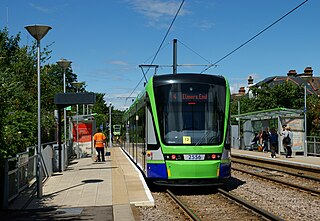
The Stadler Variobahn is a German-designed model of articulated low-floor tram and light rail vehicle. Since its introduction in 1993, the Variobahn has been manufactured variously by ABB, Adtranz, Bombardier Transportation, and since 2001 by Stadler Rail. As of 2009, 254 trams have been ordered, with an additional 110 on option. A unit costs about €2.5 million.

Nr II is a class of articulated six-axle, chopper-driven tram operated by Helsinki City Transport (HKL) on the Helsinki tram network. All trams of this type were built by the Finnish metal industry corporation Valmet between the years 1983 and 1987.

The Helsinki Regional Transport Authority is the inter-municipal authority that maintains the public transportation network of the nine municipalities of Greater Helsinki, Finland.

Koivusaari metro station is a station located underwater on the Länsimetro extension of the Helsinki Metro.

Matinkylä (Finnish) or Mattby (Swedish) is an underground station of the western metro extension (Länsimetro) of the Helsinki Metro. It is located at the southern end of Iso Omena shopping centre. 3 December 2022, the extension from Matinkylä to Kivenlahti opened as part of the second phase of the Länsimetro. The station serves up to 30,000 people on weekdays. It is located 1,6 kilometres east from Finnoo metro station and 1,9 kilometres west from Niittykumpu metro station.
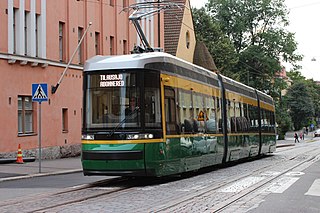
Artic, styled as ARTIC or ForCity Smart, is an articulated low-floor tram model designed and manufactured by Škoda Transtech Oy in Finland. Trams of the design are in operation in Finland, Germany and Czechia, with further large orders in these countries. The design was subsequently rebranded under the Škoda ForCity brand.

The Helsinki second metro line is a common name for planned extensions to the Helsinki Metro, intended to be developed after the Länsimetro extension has been completed.
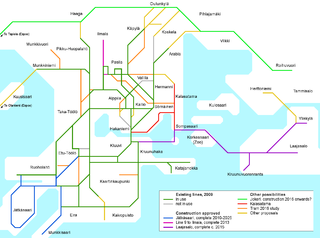
The city of Helsinki has plans for a radical expansion of the tram network within the 2021–2035 time horizon, as laid out in the Helsinki City Plan, approved by the City Council in October 2016. Below is a list of confirmed and proposed future expansions of the network. The largest confirmed projects are the 25-kilometre (16 mi) trunk line 550 ("Jokeri") and the 10-kilometre (6.2 mi) connection in the direction of East Helsinki to the island of Laajasalo, which will include the longest bridge in Finland. Together, these two will effectively double the track length of the network.
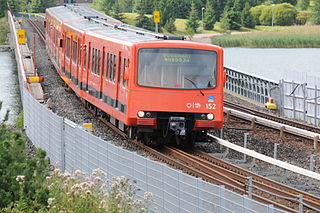
The HKL Class M100 is the first and oldest class of metro trains in use on the Helsinki Metro. One train consists of two individually numbered cars. A total of 42 units were manufactured between 1977 and 1984.

The HKL Class M300 is a class of metro trains operated by Metropolitan Area Transport Ltd in use on the Helsinki Metro. 20 four-carriage trains were built between 2014 and 2016 by Construcciones y Auxiliar de Ferrocarriles for the Länsimetro extension. In November 2019, HKL announced the purchase of five additional trains, delivered in 2022.

